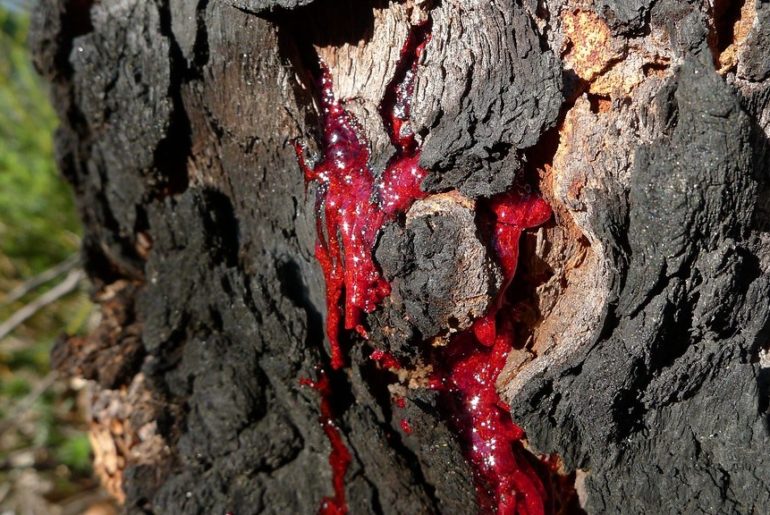This wood has distinctive deep red, which can be found in some areas of South America like Brazil.
While aged bloodwoods color turns to dark, but it’s not something to be considered. So this is a great wood to use in indoor projects. The wood is very dense, with a tight fine, mostly linear grain.
This tree is of medium height with a trunk diameter of about 18 inches on average.
The blood tree is highly resistant to insects and is a favorite of the crafts and artists because it polishes well and has a wonderful color.
However, working with it is very difficult without a carbide cutting tool. Common uses include making decorative veneer, good furniture, canvas, parquet flooring, and turned projects.
Tips on working with Bloodwood
The use of this beautiful wood is very common in the wood arts. But there are some things to consider when working with:
- When sanding, be careful not to overheat the workpiece, because cracks could result.
- Bloodwood tends to be brittle and can splinter easily while being worked.
- This wood is good for turned projects.
- Bloodwood is suitable for handmade artwork.
- This wood is a good choice for lath art and inlay wood art.
- It is not suitable for fractal wood burning. See the best wood for fractal burning.
- It is also not suitable for pyrography because it does not have a clear color. See the best wood for wood burning art.
- Bloodwood is suitable for carving but due to high density, you should use sharp tools.
Here are some features of this wood:
Lichtenberg Wood Burning eBook
Download Lichtenberg Wood Burning eBook
One of the modern techniques for creating wooden artwork is called Lichtenberg wood Burning. In this eBook, we are going to introduce this newfound art to you.
This technique is known with some different names such as Lichtenberg wood burning, fractal wood burning, and electricity wood art.
This technique should not be confused with wood burning art or pyrography. The art of pyrography on wood is the art of creating motifs and designs by burning with hot metal tools on objects such as wooden surfaces.
Lichtenberg burning is a wood-burning technique for creating designs with electricity.
This eBook is a comprehensive guide on Lichtenberg Wood Burning. All you need to know for Lichtenberg Wood Burning is here.
This is a limited-time offer, order now to get access to the future eBook releases.
Bloodwood, Satine
Brosimum rubescens (syn. B. parents)
Tropical South America
80-150 ft (25-45 m) tall, 4-7 ft (1.2-2.1 m) trunk diameter
66 lbs/ft3 (1,050 kg/m3)
90, 1.05
2,900 lbf (12,900 N)
25,290 lbf/in2 (174.4 MPa)
3,013,000 lbf/in2 (20.78 GPa)
14,310 lbf/in2 (98.7 MPa)
Radial: 4.6%, Tangential: 7.0%, Volumetric: 11.7%, T/R Ratio: 1.5
Heartwood is a bright, vivid red. Color can darken to a darker brownish red over time with exposure to light. Applying a thick protective finish, and keeping the wood out of direct sunlight can help slow this color shift. Well defined sapwood is a pale yellowish color, though, given the typically large trunk diameters, it’s seldom seen or included in imported lumber.
The grain is usually straight or slightly interlocked. Has a fine texture with good natural luster, and is also somewhat chatoyant.
Reported to be very durable, and resistant to most insect attacks.
Has a mild scent when being worked.
The wood’s dust has been reported as occasionally causing effects such as thirst and salivation, as well as nausea. Can also cause skin irritation.
Widely available in wide boards, as well as smaller turning squares and blanks. Many boards exhibit only a dull reddish-brown coloration; truly blood-red pieces are the ideal. Prices are moderate to moderately high for an imported hardwood.
Information used with permission The Wood Database.


Comments
Pingback: Red Colored Woods | Wood Dad